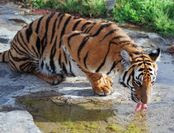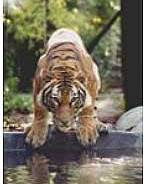Running Head: LEADERSHIP AND INTELLIGENCE IN THE ORGANISATION:
The Department of Wildlife and National Park
BY
MOHD SAIPUDDIN HAJI MAT YUNUS
G0914351
Paper submitted as partial fulfilment of the requirement for Master Human Science Industrial / Organisation Psychology supervised by ………………………at the Department of Psychology of the International Islamic University Malaysia
CENTRE OF HUMAN DEVELOPMENT AND APPLIED SOCIAL SCIENCES
CERDAS
KULLIYYAH ISLAMIC REVEAL KNOWLEDGE AND HUMAN SCIENCES
2010 Masihi_1431Hijrah
INTRODUCTION
According to Bryman (1996) as cited in Millward (2005) notes, however, that most researchers would not argue with a definition of leadership as the process (act) of influencing the activities of an organized group in its efforts towards goal setting and goal achievement’ (Stogdill, 1950:3) as cited in Millward, 2005. The influence process is inextricably linked with groups and the group process. In the early stages of leadership research, the ability to lead was attributed to distinctive traits (so-called ‘great man’ theory). However, a comprehensive and landmark review by Stogdill (1948) as cited in Millward (2005) concluded that there was no evidence for this claim, and research took another turn. In particular, the focus shifted towards understanding how exactly leaders behave, and to linking different group processes with different styles of behaviour.
According to Brodbeck (2008) as edited by Nik Chmiel, (2008) mention that leadership in organizations, means having and being seen to have the ability to influence and enable others to contribute toward the success of their work unit or organization.
Leader Traits
According to Brodbeck (2008) as edited by Chmiel (2008) mention that from the beginning of leadership research up until about the 1960’s most leadership research focused on personal characteristics of leaders (e.g., intelligence, temperament. Motives, personal values) following the idea that “a leader is born- not made”.
It seems that leadership success criteria are related to certain leadership traits. For example traits like high energy level and stress tolerance help managers to cope with the hectic pace of their job, the long hours, and the frequently encountered stressful interpersonal situations, and self-confidence(i.e., self efficacy, self-esteem), relates positively to advancement and being perceived as a charismatic leader (for a review about personality and leadership, see Judge, Bono, Ilies, & Gerhard, 2002)
Note that there are some close relationships between personality traits, like intelligence, and certain skill, like abstract thinking.
Charismatics leadership is usually defined more narrowly than tarnsfomational leadership. Behaviors typical of charismatics leaders are for example, the articulation of appealing visions, communication of high expectations and expression og high confidence in followers.
According to West (2002) edtied by Chmiel (2008) mention that the leader’s task also includes helping team members develop their skill and abilities such as cognitive ability.
Cognitive ability (Intelligence) Tests
Psychometric tests are standardized measures designed to assess a specific construct, and can be divided into two main categories: cognitive ability tests (Intelligence test) and personality tests (e.g., Smith & Smith, 2005) as cited in Chmiel (2008). Cognitive abilities tests, or tests of general mental ability (“g” or GMA), measure general intelligence or specific aptitude such as numerical, verbal, spatial ability, while personality tests measure personality dimensions such as conscientousness, extrovertion, and so forth.. There is variation across Europe in relation to the use of cognitive ability test (Intelligence Test) (Salgado & Anderson as cited in Anderson, Salgado, Schinkel and Snell (2008): They are more used in Belgium, Britain, the Netherlands, Portugal, and Spain than in France, Germany, Greece, Ireland, or Italy; also they are more frequently used in Europe than in the United States. Candidates responds moderately well to cognitive tests (Chan & Schmitt, 2004; Steiner & Gilliland, 1996) as cited in Anderson et al., (2008), but tends to rate tests with concrete items as more job-related than abstracts tests (Smither et al., 1993) as cited in Anderson et al. (2008) as edited by Chmiel (2008). Hence, organizations may generate higher performance from candidates by selecting ability tests which have high face validity.
Cognitive ability tests are generally based upon general mental ability, GMA or “g”, and meta-analyses have demonstrated notably robust predictive validity for such tests (Bertua, Anderson, & Salgado, 2005; Hunter & Hunter, 1984; Levine, Sector, Menon, Narayanan, & Cannon-Bowers, 1996; Salgado & Anderson, 2002, 2003; Salgado, Anderson, Moscoso, Bertua, & de Fruyt, 2003; salgado, Anderson, Moscoso, Bertua, de Fruyt, & Rolland, 2003; Schmitt, Gooding, Noe, & Kirsch, 1984) as cited in Anderson et al., (2008)
Some Researchers think individual differences in intelligence are of great importance in understanding why people bahve in different ways from each others, whereas others argue that intelligence is an almost valueless concept. Some researchers ( e.g., H.J Eysenck, 1981) as cited in Eysenck 2004) believe that individual differences in intelligence are almost entirely due to heredity, but others (e.g., Kamin, 1981) claim that only environmental factors are of importance.
As reasonable definition of intelligence was offered by Sternbergand Ben-Zeev (20010, p. 368) as cited in Eysenck (2004): “the ability to learn from experience and to adapt to the surrounding environment”.
Cultural differences in conceptions of intelligence do exist, but they are not typically very great. Sternberg, Conway, Ketron, and Berstien (1981) found that there were three ingredients to Americans’ conceptions of intelligence: verbal ability, practical problem solving, and social competence.
Theories of Intelligence
We have considered aspects of the traditional theory of intelligence. This theory had its origins in the work of spearman (1972) as cited in Eysenck (2004), but was subsequently endorsed by several theorist including H.J. Eysenck (1979) as cited in Eysenck (2004) and Herrnstein and Murray (1994) as cited in Eysenck (2004). Key assumptions of the traditional theory are as follows:
o Individual differ in a single psychological process that can be assessed by the general factor of intelligence or by IQ.
o Intelligence tests provide an adequate assessment of human intelligence
o Intelligence depends mainly on genetic factors. H.J Eysenck (1979) as cited in Eysenck (2004) argued that, “Intelligence as measured by IQ tests has a strong genetic basis; genetic factors account for an estimated 80% of the total variance.”
o The fact that intelligence is largely inherited means it is difficult to change an individual’s level of intelligence.
Pg 435 Eysenck (2004)
Leadership Style
There are many different models of leadership style, but common to all is the assumption that leadership behaviour can be described in two main ways: task-oriented and relationship-oriented. The task style is oriented to managing task accomplishment (where the leader defines clearly and closely what subordinates should be doing and how, and actively schedules work for them), whilst the relationship style is oriented to managing the interpersonal relations to group members (by demonstrating concern about subordinates as people, responsiveness to subordinate needs and the promotion of team spirit and cohesion).
Other terms have been used to differentiate between these two distinct sets of orientation, including ‘initiating structure’ versus ‘consideration’ (Fleishman, 1953) as cited in Millward, 2005, ‘production-oriented’ versus people-oriented’ (Blake & Mouton, 1964) as cited in Millward, 2005, ‘production-centered’ versus ‘employee-centered (Likert,1967), ‘task emphasis’ versus relations emphasis’ (Fiedler, 1967) as cited in Millward, 2005 and ‘performance concern’ versus ‘maintenance concern’ (Misumi, 19850 as cited in Millward, 2005
The ‘initiating structure/ consideration’ distinction has had a major impact on leadership theory and research since the 1950s. It forms the basis of many leadership measures, for instance the Supervisory Behaviour Description Questionnaire (Fleish, 1953) as cited in Millward,2005- a vehicle for asking subordinates how they think should behave as a supervisor- and the Leader Behaviour Description Questionnaire (LBDQ); (Fleisman, 1953) as cited in Millward, 2005 probably the most frequently employed measure of leadership.
Some highly specialized Q-sorts include the Leadership Q-Test (Cassel,1958) as cited in Cohen and Swedlik, (2010) and the Tyler Vocational Classification System (Tyler, 1961) as cited in Cohen and Swedlik , (2010).
Personal Characteristics Associated with Leadership
In the last 100 years, many attempts have been made to identify the personal characteristics associated with leader emergence and leader performance Aamodt, (2010).
Leader Emergence
Leader emergence is the idea that people who become leaders possess traits or characteristic different from people who do not become leaders. That is, people who become leaders, such as Barrack H. Obama and CEOs Carly Fiorina and Michael Dell, share traits that your neighbor or a food preparer at McDonald’s does not. If we use your school as an example, we would predict that the students in your student government would be different from students who do not participate in leadership activities. In fact, research indicates that to some extent, people are “born’ with a desire to lead or not lead, as somewhere between 17% (Ilies, Gerhardt,&Le, 2004) as cited in Aamodt, 2010 and 30% (Arvey, Rotundo, Johnson, Zhang,&McGue,2006) as cited in Aamodt, (2010) of leader emergence has a genetic basis (Ilies et al.,2004) as cited in Aamodt, (2010).
Does that mean that there is a “leadership gene” that influences leader emergence? Probably not. Instead we inherit certain traits and abilities that might influence our decision to seek leadership.
Though early reviews of the literature suggested that the relationship between traits and leader emergence is not very strong, as shown in Table 12.1, more recent reviews suggest that
1. People high in openness, conscientiousness, and extraversion, and low in neuroticism are more likely to emergence as leaders than their counterparts (Judge, Bono, Ilies & Gerhardtm, 2002) as cited in Aamodt, 2010.
2. High self-monitors (people who adapt their behavior to the social situation) emerge as leaders more often than low self-monitors (Day & Schleicher, 2006; Day, Schleicher,Unckless, & Hiller, 2002) as cited in Aamodt, (2010).
3. More intelligent people are more likely to emerge as leaders than are less intelligent people (Judge, Colbert, & Ilies, 2004) as cited in Aamodt, (2010).
4. Looking at patterns of abilities and personality traits is more useful than looking at individual abilities and traits (Foti & Hauenstein, 2007) as cited in Aamodt, (2010)
It is especially perplexing that some of the early reviews concluded that specific trait are seldom related to leader emergence because both anecdotal evidence and research suggest that leadership behavior has some stability (Law,1996) as cited in Aamodt, (2010). To illustrate this point, think of a friend you consider to be a leader. In all probability, that person is leader in many situations. That is, he might influence a group of friends about what movie to see, make decision about what time everyone should meet for dinner, and “take charge” when playing sports
Conversely, you probably have a friend who has never assumed a leadership role in his life. Thus, it appears that some people consistently emerge as leaders in a variety of situations, whereas others never emerge as leaders.
Perhaps one explaination for the lack of agreement on a list of traits consistently related to leader emergence is that the motivation to lead is more complex than originally thought. In a study using a large international sample, Chan and Drasgow, (2001) as cited in Aamodt, (2010) found that the motivation to lead has three aspects (factors): Affective identity, non calculative, and social-normative. People with an affective identity motivation become leaders because they enjoy being in charge and leading others. Of the three leadership motivation factors, people scoring high on this one tend to have the most leadership experience and are rated by others as having high leadership potential. Those with a non calculative motivation seek leadership position when they perceive that such positions will result in personal gain. For example, becoming a leader may result in an increase in status or in pay. People with a social-normative motivation become leaders out of a sense of duty. For example, a member of the Kiwanis Club might agree to be the next president because it is “his turn”, or a faculty member might agree to chair a committee out of a sense of commitment to the university.
Individuals with high leadership motivation tend to obtain leadership experience and have confidence in their leadership skills (Chan & Drasgow, 2001) as cited in Aamodt, (2010). Therefore after researching the extent to which leadership is consistent across life, it makes sense that Bruce (1997) as cited in Aamodt, (2010) concluded that the best way to select a chief executive officer (CEO) is to look for leadership qualities (e.g., risk taking, innovation, vision) and success early in person’s career. As support for his proposition, Bruce cites the following examples:
1. Harry Gray, the former chair and CEO of United Technologies, demonstrated vision, risk taking, and innovation as early as the second job in his career.
2. Ray Tower, former president of FMC Corporation, went way beyond his job description as a salesperson in his first job to create a novel sales training program. Tower continued to push his idea despite upper management’s initial lack of interest.
3. Lee Iacocca, known for his heroics at Ford and Chrysler, pioneered the concept of new car financing. His idea of purchasing a 1956 Ford for monthly payments of $56 (“Buy a ’56 for $56”) moved his sales division from last in the country to first. What is most interesting abaout this success is that Iacocca didn’t even have the authority to implement his plan-but he did it anyway.
The role of gender in leader emergence is complex. Meta-analysis indicate that men and women emerge as leaders equally often in leaderless group discussions (Benjamin, 1996) as cited in Aamodt, 2010), men emerge as leaders more often in short-term groups and group carrying out tasks with low social interaction (Eagly & Karau, 1991) as cited in Aamodt, (2010), and women emerge as leaders more often in groups involving high social interaction (Eagly & Karau, 1991 as cited in Aamodt, (2010).
Leader Performance
In contrast to leader emergence, which deals with the likelihood that a person will become a leader, leader performance involves the idea that leaders who perform well possess certain characteristics that poorly performing leaders do not. For example, an excellent leader might be intelligent, assertive, friendly and independent, whereas a poor leader might be shy, aloof, and calm. Research on the relationship between personal characteristics and leader performance has concentrated on three areas: traits, needs and orientation.
Traits
As shown in Table 12.1, a mete- analysis by Judge et al (2002) as cited in Aamodt (2010) found that extraversion, openness, agreeableness, and conscientiousness were positively related to leader performance. A meta-analysis by Youngjohn and Woehr (2001) as cited in Aamodt, (2010) also found that management, decision making, and oral-communication skills were highly correlated with leadership effectiveness
As was the case with leader emergence, high self-monitors tend to be better leaders than do low self-monitors (Day & Schleicher, 2006; Day et al., 2002) as cited in Aamodt, (2010). The concept of self monitoring is especially interesting, as it focuses on what leaders do as opposed to what they are. For example, a high self-monitoring leader may possess the trait of shyness and not truly want to communicate with other people. She knows, however, that talking to others is an important part of her job, so she says hello to her employees when she arrives at work, and at least once a day stops and talks with each employee. Thus, our leader has the trait of shyness but adapts her outward behavior to appear to be outgoing and confident.
An interesting extension of the trait theory of leader performance suggests that certain traits are necessary requirements for leadership excellence is a function of the right person being in the right place at the right time. The fact that one person with certain traits becomes an excellent leader while another with the same traits flounders may be no more than the result of timing and chance. For example, Lyndon Johnson and Martin Luther King, Jr were considered successful leaders because of their strong influence on improving civil rights. Other people prior to the 1990s had had same thoughts, ambitions, and skills as King and Johnson, yet they had not become successful civil rights leaders, perhaps because the time had not been right.
Cognitive Ability
A meta-analysis of 151 studies by Judge et al. (2004) as cited in Aamodt (2010) found a moderate but significant correlation (r=.17) between cognitive ability and leadership performance. The mete-analysis further discovered that cognitive ability is most important when the leader is not distracted by stressful situations and when the leader uses a more directive leadership style. In studies investigating the performance of united states Presidents, it was found that the presidents rates by historians as being the most successful were smart and open to experience, had high goals, and interestingly had the ability to bend the truth (Dingfelder, 2004; Rubenzer & Faschinbauer,2004) as cited in Aamodt (2010) has expanded on the importance of cognitive ability by theorizing that the key to effective leadership is the synthesis of three variables:wisdom, intelligence (academic and practical), and creativity.
Needs
A personal characteristic that has received some support pertains to a leader’s need for power, need for achievement, and need for affiliation. In fact, as shown in Table 12.1, a meta- analysis by Argus and Zajack (2008) as cited in Aamodt (2010) found a significant relationship between need for achievement and leader performance. Research by McClelland and Burnham (1976) as cited in Aamodt 2010 and McClelland and Botatzis (1982) also as cited in Aamodt 2010 demontrates that high-performance managers have a leadership motive pattern, which is high need for power and a low need for affiliation. The need is not for personal power but for organizational power.
This pattern of needs is thought to be important because it implies that an effective leader should be concerned more with results than with being liked. Leader who needs to be liked by their subordinates will have a tough time making decisions. A decision to make employees work overtime, for example, may be necessary for the organization’s survival, but it will probably be unpopular with employees. Leaders with high affiliation needs may decide that being liked is more important than being successful, causing conflict with their decision.
This theory would also explain why internal promotions often do not work. Consider, for example, a person who worked for six years as a loan officer. He and ten coworkers often went drinking together after work and went away on weekends. One day he was promoted to manager, and he had to lead the same people with whom he had been friends. The friendships and his need to be liked hindered the new manager when giving orders and disciplining his employees. When he tried to separate himself from his friends, he was disciplining his employees. When he tried to separate himself from his friends, he was quickly thought of as being “too good” for them- a tough situation with no apparent solution, according to this theory.
This does not mean that a leader should not be friendly and care about subordinates. But successful leaders will not place their need to be liked above the goals of the organization. President Richard Nixon was thought to have a high need to be liked. He would often make a tough decision and then apologize for it because he wanted to be liked both the public and the press. Needs for power, achievement, and affiliation can be measured through various psychology tests.
The most commonly used is the Thematic Apperception Test (TAT) The TAT is a projective test in which a person is shown a series of pictures and asked to tell a story about what is happening in each. A trained psychologist then analyzes the stories, identifying the needs themes contained within them. Obviously, this technique is time-consuming and requires a great deal of training.
Another commonly used measure is the Job Choice Exercise (JCE), developed by Stahl and Harrell (1982) as cited in Aamodt (2010). with the JCE, the person reads descriptions of jobs that involve varying degrees of power, achievement, and affiliation needs and rates how desirable he finds each particular job. These rating are then subjected to a complicated scoring procedure that uses regression analysis to reveal scores on the tree needs categories.
Another method to determine leaders’ needs is to examine the themes that occur in their writing and speeches. In one interesting use of this method, it was found that Presidents Franklin Roosevelt, Kennedy, and Reagan had high needs for power; Presidents Harding, Truman, and Nixon had high needs for affiliation; and Presidents Wilson, Hoover, and Carter had high needs for achievement (Winter,1988) as cited in Aamodt (2010).
Gender
As with leader emergence, meta-analysis suggest that the role of gender in leader effectiveness is complex. When all studies are combined, men and women appear not to differ in leadership effectiveness (Eagly Karau, & Makhijani, 1995) as cited in Aamodt (2010). However, men were more effective as leaders in situations traditionally defined in less masculine terms. Though men and women appear to be equally effective leaders, a meta-analysis of leadership style indicated that women were more likely than men to engage in behaviors associated with high-quality leadership (Eagly, Johannesen-Schmidt, & van Engen, 2003) as cited in Aamodt, (2010)
Task Versus Person Oriented
Over the last 45 years, three major schools of thought- Ohio State Studies (Fleishman, Harris, & Burtt, 1955), Theory X (McGregor, 1960) and Managerial Grid (Blake & Mouton, 1984) as cited Aamodt, (2010) - have postulated that differences in leaders performance can be attributed to differences in the extent to which leaders are task versus person oriented. As shown in Figure 12.1, though the three schools of thought use different terms, they say similar things.
Person oriented leaders such as country club leaders, Theory Y leaders, and leaders high in consideration act in warm and supportive manner and show concern for their subordinates. Person-oriented leaders believe that employees are intrinsically motivated, seek responsibility, are self-controlled, and do not necessarily dislike work. Because of these assumptions, person-oriented leaders consult their subordinates before making decisions, praise their work, ask about their families, do not look over their shoulder, and use a more “hands-off” approach to leadership. Under pressure, person-oriented leaders tend to become socially withdrawn (Bond,1995) as cited in Aamodt (2010).
Task-oriented leaders such as task-centered leaders, Theory X leaders, and leaders high in initiating structure define and structure their own roles and those of their subordinates to attain the group’s formal goals.
Task oriented leaders see their employees as lazy, extrinsically motivated, wanting security, undisciplined, and shirking responsibility. Because of these assumptions, task oriented leaders tend to manage or lead by giving directives, setting goals, and making decisions without consulting their subordinates. Under pressure, they become anxious, defensive, and dominant (Bond, 1995) as cited in Aamodt, (2010), Interestingly, task-oriented leaders tend to produce humor (e.g., tell jokes and stories), whereas person-oriented leaders tend to appreciate humor (e.g., listen to others’ jokes) (Philbrick, 1989) as cited in Aamodt, (2010). As shown in Figure 12.2, when using the terms from Figure 12.1, the best leaders (team) are both task and person oriented, whereas the worst (impoverished) are neither task nor person oriented. Some leaders (middle-of-the-road) have moderate amounts of both orientations.
A meta-analysis by Judge, Piccolo, and Ilies (2004) as cited in Aamodt, (2010) found that higher scores on consideration or on initiating structure were associated with such positive leadership’s criteria as follower satisfaction and group performance. The relationship between person orientation (consideration) and follower satisfaction, follower motivation, and ratings leadership effectiveness were higher than the relationships between task orientation (initiating structure) and these same three leadership’s criteria.
A leader’s task or person orientation can be measured by several instruments two of which are the Leadership Opinion Questionnaire (LOQ) and the Leader Behavior Description Questionnaire (LBDQ). The LOQ is filled out by supervisors or leaders who want to know their own behavior style. The LBDQ is completed by subordinates to provide a picture of how they perceive their leader’s behavior. A meta-analysis by Eagly and Johnson (1990) as cited in Aamodt, (2010) indicated that in laboratory studies, women were more likely to have a person orientation and less likely to have a task orientation than were men. They did not find any such difference in studies that were conducted in actual organizations. They did, however, find small gender differences in that women were more likely to use a more participative approach and more likely to use a more approach.
As depicted in Figure 12.2 theoretically, person-oriented leaders should have satisfied employees, whereas task-oriented leaders should have productive employees. Leaders scoring high in both (called team leadership) should have satisfied and productive employees, whereas leaders scoring low in both (called impoverished leadership) should have unhappy and unproductive employees (Fleishman & Harris, 1962; Hucthison, Valentino, & Kirkner, 1998; Korman,1966; Pool, 1997) as cited in Aamodt, (2010).
Although these predictions certainly make sense, the meta-analysis by Judge and his colleagues (2004) as cited in Aamodt, (2010) found that consideration scores (person orientation) were strongly correlated with follower satisfaction, follower motivation, and creating of leadership effectiveness than were initiating structure scores (task orientation). Correlations with the performance of the work group were similar in magnitude for both consideration and initiating structure.
To complicate matters further, the relationship between person and task orientation is probably more complex than was first thought. Several studies have shown that leader experience and knowledge and such external variables as time pressures and work importance tend to moderate the relationship between person-orientation scores and satisfaction and between task-orientation scores and subordinate performance.
Unsuccessful Leaders
The traits and behaviors of unsuccessful leaders are not necessarily the opposite of those of successful leaders (Hackman & Wageman, 2007) as cited in Aamodt, (2010). In a departure from research to identify characteristics of successful leaders, Hogan (1989) as cited in Aamodt, (2010) attempted to identify traits of unsuccessful leaders. Hogan was interested in investigating poor leaders because, according to both emphirical researches and anecdotal accounts, most employees report that one of the greatest sources of stress in their jobs is their supervisors’ poor performance, strange behavior, or both. This finding should come as no surprise: You can probably quickly recall many examples of poor performance or strange behavior with current of former supervisors.
Lack of Training
On the basis of years of research, Hogan (1989) as cited in Aamodt, (2010) conclude that poor leader behavior has three major causes. The first is a lack of leadership training given to supervisors. The armed forces are among the few organizations that require supervisors to complete leadership training before taking change of groups of people. The norm for most organization, however is either to promote a current employee or hire a new employee and place him directly into leadership role. If training is ever provided, it is usually after the promotion and well after supervisor has begun supervising. The serious consequences of this lack of training can best be understood if we imagine allowing doctors to perform surgery without training or truck drivers to drive on the highways without first learning how to drive.
Cognitive Deficiencies.
The second cause of poor leadership stems from cognitive deficiencies. Hogan (1989) as cited in Aamodt, (2010) believes that poor leaders are unable to learn from experience and are unable to think strategically-they consistently make the same mistakes and do not plan ahead. Support for this concept comes from the meta-analysis by Judge et al. (2004) as cited in Aamodt, (2010) which found a significant relationship between cognitive ability and leader performance.
The manger of a local convenience store that I frequent is an example of a person who does not learn from his mistakes. The manager did not give employees their work schedules until one or two days before they had to work. The employees complained because the hours always changed and they could not schedule their personal, family, and social lives. But the manager continued to do it his way, and most of the employees quit. Eight years later, he still does it his way, and his employees still leave at a high rate.
Personality
The third, and perhaps most important, source of poor leadership behavior involves the personality of the leader. Hogan (1989) as cited in Aamodt, (2010) believed that many unsuccessful leaders are insecure and adopt one of three personality types: the paranoid or passive-aggressive, the high likability floater, and the narcissist.
The source of insecurity for leaders who are paranoid, passive-aggressive, or both is some incident in their life in which they felt betrayed. This paranoid/ passive-aggressive leader has deeply rooted, but perhaps unconscious, resentment and anger. On the surface, these leaders are charming, quiet people who often compliment their subordinates and fellow workers. But they resent the success of others and are likely to act against subordinates in a passive-aggressive manner; that is, on the surface they appear to be supportive, but at the same time they will “stab’ another person in the back.
The type of leader who is insecure and seldom rocks the boat or causes trouble is known as a high-likability floater. This person goes along with the group, is friendly to everyone, and never challenges anyones’s ideas. Thus, he travels through life with many friends and no enemies. The reason he has no enemies is because he never does anything, challenges anyone, or stands up for the rights of his employees. Such leaders will be promoted and never fired because even though they make no great performance advances, they are well liked. Their employees have high morale but show relatively low performance.
Narcissists
Are leaders who overcome their insecurity by overconfidence. They like to be the center of attention, promote their own accomplishments, and take most, if not all, of the credit for the success of their groups-but they avoid all blame for failure.
Rather than concentrate on traits as did Hogan, Shen and her colleagues (2008) as cited in Aamodt, (2010) collected critical incidents of an ineffective leader behavior and found that such behavior fell under ten basic dimensions:
1. Engaging in illegal and unethical behavior
2. Avoiding conflict and people problems
3. Demonstrating poor emotional control (e.g., yelling and screaming)
4. Over-controlling (e.g., micromanaging)
5. Demonstrating poor task performance
6. Poor planning, organization, and communication
7. Starting or passing on rumors or sharing confidential information
8. Procrastinating and not meeting time commitments
9. Failing to accommodate the personal needs of subordinates
10. Failing to nurture and manage talent
Issues include the factors which influence the amount of effort expended at work, the influence of job satisfaction on levels of performance and organizational commitment, the processes that underly group behaviour and decision making, and the exercise of power and influence in organizations. Also of interest is the nature of leadership and followership, and the management of organizational change.
So far we have largely been talking about top management. The focus on top management has also led to a renewed interest in the process of leadership both within senior teams and at every level within the organization (see, e.g., Schruijer, 1992; Sparrow, 1994 as cited in Doyle 2002). Shell for instance, encapsulates its vision as “Leaders leading Leaders” (Steel, 1997 as cited in Doyle 2002). Much is made of the ability to formulate and communicate vision. From ideas such as this, Bass and his colleagues proposed the concept of transformational leadership, in which the leader’s ability to inspire and empower followers and to create a belief in the attainability of the vision are stressed (Bass,1999;Bass & Avolio, 1990 as cited in Doyle 2002). Many culture change programmes begin with leadership development of senior managers, which then spreads more widely throughout the organization. Schruijer and Vansina (1999a, 1999b) as cited in Doyle 2002 edit and provide a commentary on a fascinating collection of papers that consider the role of leadership in organizational change. They raise a number of important and difficult questions concerning top-level leadership in organizations, including the extent to which one should focus on the individual qualities of the leader or on the incredibly complex set of relationships between leaders and followers. For instance, followers may exhibit dependence on, trust in, loyalty, and commitment to the leader but nevertheless aspire to an complete strongly for his or her job (Berg, 1998 as cited in Doyle 2002). Schruijer and Vansina conclude that one thing characterizing successful leaders in today’s turbulent business environment is their capacity to collaborate with diverse groups and stakeholders to achieve strategic objectives. The dynamics of this kind of shared leadership are illuminated by the work of De Vries, Roe, and Tailieu (1999) as cited in Doyle 2002 and Rijaman (1999) as cited in Doyle 2002, who both emphasize a “follower-centred” approach. Alimo-Metcalfe and Alban-Matcalfe (2000) as cited in Doyle 2002 are also considering the influence of “nearby” leaders rather than top management and conceptualizing the former as “servants” to their followers. However, as Bass (1999) as cited in Doyle 2002 and others have stressed, transformational leadership is needed as well as more mundane management that organizes and coordinates work and provides the structure for implementing the fine detail of change.
LITERATURE REVIEW
Leadership has always been an important topic in work and organizational psychology and much research has been devoted to the topic. This chapter describes the developments in this field over the last decades. Traits, style, and contingency theories of leadership in organizations are presented, as well as several alternative approaches to studying leadership. Special attention is also given to transformational/ charismatic leadership. The growing importance of global and international world business creates a strong demand for managers who are sophisticated in international management and skilled at working with people from other countries. This has resulted in increased attention for cross-cultural perspectives the leadership field. Other currents of change, such as the developing information technology and the increased importance of team and other lateral organizing mechanisms are influencing work and organizations in a pervasive manner. We conclude the chapter by presenting several possible ways in which these trends may change the role of leadership in future organizations.
Legends and myths about what distinguishes “great leaders” from “commoners” seem to have always attracted people. Bass writes: “The study of leadership rivals in age the emergence of civilization, which shaped its leaders as much as it was shaped by them. From its infancy, the study of history has been the study of leaders-what they did and why they did it’ (1990a:3) as cited in Den Hartog and Koopman (2001). Leadership still fascinates scholars as well as the general public. However, the term “leadership means different things to different people. Definitions of leadership vary in terms of emphasis on leader abilities, personality traits, influence relationship, cognitive, versus emotional orientation, individual versus group orientation, and appeal to self versus group orientation, and appeal to self versus collective interests. Definitions also vary in whether they are primary descriptive or normative in nature as in their relative emphasis on behavioural styles (Den Hartog, Koopman, Theirry, Wilderom, Maczynski & Jarmuz, 1997) as cited in Den Hartog and Koopman, 2001. Leadership is sometimes distinguished from management (e.g., Kotter, 1990; Zaleznik,1977) as cited in Den Hartog and Koopman, 2001 or seen as one of several managerial roles (e.g., Mintzberg, 1989) as cited in Den Hartog and Koopman, 2001.
Bryman (1992) as cited in Den Hartog and Koopman et al.,2001 states that most definitions of leadership emphasize three main elements: group, influence, and goal.. Table 9.1 provides several examples of definitions of leadership.
Table 9.1 Defining Leadership (Den Hartog and Koopman, 2001)
Anglo_Saxon definitions of Leadership
o Leadership is the influential increment over and above mechanical compliance with the routine directives of the organization (Kartz & Kahn, 1978) as cited in Den Hartog and Koopman, 2001.
o Leadership is the process of influencing the activities of an organized group toward goal achievement (Rauch & Behling, 1984) as cited in Den Hartog and Koopman, 2001.
o Yukl (1998) as cited in Den Hartog and Koopman, 2001 broadly defined leadership as influence processes affecting the interpretation of even followers, the choice of objectives for the group or organization, the organization of work activities to accomplish the objectives, the motivation of followers to achieve the objectives, the maintainance of cooperative relationships and teamwork,and the enlistment of support and cooperation from people outside the group or organization.
o Leadership is defined in terms of a process of social influence whereby a leader steers members of a group towards a goal (Bryman, 1992) as cited in Den Hartog and Koopman, 2001
o Leadership is the ability of an individual to motivate others to forego self interest in the interest of a collective vision, and to contribute to the attainment of that vision and to the collective by making significant personal self-sacrifices over and above the call of duty, willingly (House & Shamir, 1993) as cited in Den Hartog and Koopman, 2001.
Another way to view leadership is in terms of the different domains leadership encompasses. Most approaches to leadership have been leader-centered. However, one can distinguish between the leader, followers, and relationship domain of leadership (Graen & Uhl-Bien, 1995) as cited in Den Hartog and Koopman, 2001. In all three domains, difference levels of analysis (i.e., individual, dyad. Group or larger collectivities) can be the focus of investigation (e.g., Yammarino & Bass, 1991).
According to Graen and Uhl-Bien (1995) as cited in Den Hartog and Koopman, 2001, leader behaviour and characteristics and their effects are the primary issues of concern in the leader-based domain. A follower-based approach would lead to hypotheses focusing on follower issues such as follower characteristics, behaviours, and perceptions or topics such as empowerment (e.g., Hollander, 1992; Meindl, 1990) as cited in Den Hartog and Koopman, 2001.
A relationship-based model takes the relationship between leader and follower as the starting point for research and theory building. Issues of concern are reciprocal influence and the development and maintainance of effective relationships (e.g., Bryman, 1992; Graen & Scandura, 1987) as cited in Den Hartog and Koopman, 2001. Graen and Uhl-Bien note that a multiple domain approach should be taken more often and that ‘careful sampling from multiple domains within the same investigation should account for more of the potential leadership contribution, and thus increase the predictive validity and practical usefulness of our Stusies’ (1995: 221).
As stated, most research in the leadership field so far has been done from a leader-centered point of view. The following section presents an overview of the major developments in leadership research and theory to date. This is followed by more extensive treatment of the most recent trend in leadership research, which focuses on so-called charismatic, transformational, or inspirational leadership. The growing importance of global and international world business creates a strong demand for managers who are sophisticated in international management and skilled at working with people from other countries (Adler, 1991) as cited in Den Hartog and Koopman (2001). This has led to increase attention for cross-cultural perspectives the leadership foeld. Therefore, the topic of international and cross-cultural research into leadership is also discussed. A discussion of the future of leadership and future leadership research concludes this chapter (Den Hartog and Koopman, 2001.)
TRENDS AND DEVELOPMENTS IN LEADERSHIP RESEARCH
Leadership has been an important topic of investigation, especially in North America, for many decades, several main trends can be distinguished in the development of the study of (business) leadership. Prior to the 1980s the main approaches to leadership were the traits, style, and contingency approach. Table 9.2 presents a historical overview of the main trends in the leadership field. The dates in this table represent rough indications of the periods in which the emphasis was on that approach. A new stage was completely abandoned; rather, a shift in emphasis occurred (Bass, 1990a; Bryman, 1992) as cited in Den Hartog and Koopman, 2001. Several alternative ways to conceptualize and study leadership have had a profound influence on the development of ideas about and research into leadership from the early 1980s onward. Below, the three aforementioned main trends and several of these alternative approaches to leadership will be described.
The Traits Approach
Early research into leadership can be characterized as a search for ‘the great man.’ Personal characteristics of leaders were emphasized and the implicit idea was that leaders are born rather than made. All leaders were supposed to have certain stable characteristics that made them into leaders. The focus was on identifying and measuring traits that distinguished leaders from non leaders or effectives from ineffective leaders (Hollander & Offermann, 1990) as cited in Den Hartog and Koopman, 2001. From these distinctions between leaders and non leaders, a profile of an ‘ideal’ leader could be derived, which could serve as the basis for selection of future leaders.
Three main categories of personal characteristics were include in the search for the ‘great man.’ First, physical features, such as height, physique, appearance, and age. Second, ability characteristics such as intelligence, knowledge, and fluency of speech. And third, personality traits such as dominance, emotional control and expressiveness, and introversion-extraversion (Bryman,1992) as cited in Den Hortog and Koopman, page167, (2001).
Table 9.2 Trends in leadership theory and research
Period Approach Core theme
Up to late 1940s Trait Leadership are born, leadership as an innate ability
Late 1940s to late 1960s
Style
What do they do; effectiveness has to do with how the leader behaves
Late 1960s to early 1980s
Contingency It all depends; effectiveness of leadership is affected by the situation/ context
Since early 1980s New leadership (including charismatic/ transformational leadership Leader need vision and inspire loyalty and emotional attachment
Adapted from Bryman (1992:1) as cited in Den Hartog and Koopman, 2010: page 165
Research up to 1950 failed to yield a consistent picture of leader traits, therefore research into this area slowed. After about 25 years the interest in traits possessed by leaders revived. In 1974, after reviewing 163 studies that had been reported between 1949 and 1970, Stogdill shows that contrary to what had been conclude from earlier reviews several universal personal traits and skills (such as vigor and persistence in the pursuit of goals, self-confidence and tolerance for uncertainty and frustration) were indeed associated with leadership (Bass, 1990a) as cited in Den Hartog and Koopman, 2001. Other studies have also shown that traits or personal characteristics do indeed play a more significant role in leadership than was concluded earlier (e.g., Kirkpatrick & Locke, 1991; Lord, De Vader & Allinger, 1986) as cited in Den Hartog and Koopman, 2001; Kirkpatrick and Locke’s (1991) as cited in Den Hartog and Koopman, 2001 review suggests that drive, a desire to lead, honesty and integrity, self-confidence, cognitive ability, and knowledge of the business are personal characteristics that distinguish leaders from non leaders. Other traits predicting effective leadership include: high energy level and stress tolerance, internal locus of control orientation, emotional maturity, socialized power motivation, moderate achievement motivation, and a low need for affiliation. (Yukl, 1998) as cited in Den Hartog and Koopman (2001).
The type of ‘traits’ under consideration in this ‘reviving’ trait approach are different form the early studies. Bryman (1992) as cited in Den Hartog and Koopman,2001 warn that there is a danger that the term ‘traits’ become so stretched that it applies to many variable on which leaders and nonleaders differ, even certain behavioral patterns such as those discussed below. Thus, although there has been a resurgence of interest in the trait approach the way in which traits are treated has changed. Also, traits are now considered along with other (situational and behavioral) variables.
Disillusionment followed the lack of empirical evidence for the existence of a ‘leadership traits profile’ in the early years of trait research. This led to a new emphasize in leadership research, the style approach.
Leadership style
The second major trend in researching leadership emphasized leadership behavior . The focus shifted from who leaders are (traits) to what leaders do (behavioral style). In this approach, effectiveness of leaders is dependent on the exerted leadership style. Whereas tha traits approach focused on stable personal characteristics which were usually thought to be largely innate (impliying selection of effective leaders rather than training), the style approach implied that leadership is a behavior pattern, which can be learned. Thus, according to this approach, once one was able to discover the ‘right’ style, people could be trained to exhibit that behavior and become better leaders (Bass, 1990a; Bryman, 1992) as cited in Den Hartog and Koopman (2001).
Most influential in this period was probably the series of questionnaire-based Ohio State studies. The Ohio State researchers concluded that leadership style could best be described as varying along two dimension, i.e., ‘consideration’ and ‘initiating structure’ (e.g., Fleishman & Harris, 1962) as cited in Den Hartog and Koopman (2001). A second major research program concerning leader behavior in this period was carried out at the University of Michigan. The results of these studies (summarized by Likert, 1961, 1967) as cited in Den Hartog and Koopman,(2001) show that they found three types of leader behavior differentiating between effective and ineffective managers: task-oriented behavior, relationship-oriented behavior, and participative leadership.
Some researchers proposed ‘universal’ theories of effective leader behavior, stating that, for instance, effective leaders are both people- and task- oriented, so-called ‘high-high’ leaders. Blake and Mouton’s (1982) as cited in Den Hartog and Koopman (2001) managerial grid is an example of such a ‘high-high’ theory. Other prominent ‘universal’ theories were based on the idea that leaders who make extensive use of participative decision procedures are more effective than other leaders (e.g., Likert, 1967; Mc Gregor, 1960) as cited in Den Hartog and Koopman (2001).
Criticism of Style Approach
There have been many criticisms of the style approach. Among the criticisms are the inconsistent findings and measurement problems, the problem of causality, the problem of the group, informal leadership, and most pressing, the lack of situational analysis (Bryman, 1992) as cited in Den hartog and Koopman (2001). Korman (1966) as cited in Den hartog and Koopman (2001) showed that the magnitude and direction of correlations between leadership styles and outcomes were highly variable and divergent. Often, correlations were not statistically significant (see also Bass, 1990a) as cited in Den Hartog and Koopman (2001). Identified measurement problems include response tendencies such as leniency effects and contamination by subordinate’s implicit theories of leadership. Assumed causality was a problem in the early studies (this also goes for trait studies). These studies were usually cross-sectional, meaning that the notion that leadership style constitutes the independent rather tahan the dependent variable is an assumption in stead of a conclusion based on investigation of this view. Since then it has been shown that causality can run both ways (Bryman, 1992) as cited in Den Hartog and Koopman (2001).
The problem of the group refers to the tendency in leadership research to focus on the group level rather than the individual or dyad levels of analysis. We will return to this below when briefly discussing the vertical dyad linkage (VDL) approach as an alternative way to study leadership. Most research described above was directed at formal, designated leaders who might behave different than informal leaders.Also, where designated leaders are not the actual group leaders the questions are probably not about the ‘right’ person (Bryman, 1992) as cited in Den Hartog and Koopman (2001).Informal and emergent leadership are still rarely studied.
The failure of the style approach to pay attention to situational characteristics that act as possible moderators of the relationship between leadership and outcomes is probably its most serious problem. Possible moderators include task characteristics (e.g., complexity, interdependence) and subordinate characteristics ( e.g., experience, motivation), but environment factors or organizational culture could also influence the shape or form of the relationship between leadership style and outcomes. Attempts to address this situational issues led to the next main trend, contingency approaches to study leadership.
Contingency Approaches
As stated, many contingency approaches can be considered as an attempt to repair what researchers saw as the deficiency of the aforementioned approaches (Smith & Peterson, 1988) as cited in Den hartog and Koopman (2001). The main proposition in contingency approaches is that the effectiveness of a given leadership style is contingent on the situation, implying that certain leader behaviors will be effective in some situations but not in others.
Fiedler’s Model
The earliest contingency theory of leader effectiveness was the theory by Fiedler (1967) as cited in Denhartog and Koopman (2001). Fiedler is well-known and heavily criticized for his least-preferred-worker’ (LPC) measure. The basic assumption is that a leader’s description of the person with whom he the greatest difficulty working reflects a basic leadership style. A second assumption is that which of the basic leadership styles contributes most to group performance varies wth the ‘situation favorability.’ This favorability is determined by weighting and combining three aspect s of the situation, namely leader-member relations, position power and task structure. For instance, a situation is least favorable for a leader when leader-member relations are poor, position power is low and the task is unstructured. The model predicts that when the situation is either highly favorable or very unfavorable, low LPC leaders are more effective than high LPC leaders. In intermediate situations, high LPC leaders should be more effective than low LPC leaders. Support for the model is at best weak.
More recently, Fiedler and Garcia (1987) as cited in Den Hartog and Koopman (2001) developed a model that deals with the cognitive abilities of leaders ( cognitive resources theory) According to this model, group performance depends on an interaction between two ‘traits’ (leader intelligence and experience), one type of leadership behavior (directive) and two aspects of situation (interpersonal stress and the nature of group task). So far, there is little emphirical support for this model.
Hersey and Balanchard’s (1969, 1977) as cieted in Den Hartog and Koopman (2001) situational leadership theory (SLT) has been a popuplar basis for leadership training for many years. Originally SLT proposes that leaders should attune their behavior to fot with the ‘maturity’ or in later writings the ‘ development level’ of the team as a whole as well as its individual members. Combining high or low task and relationship behavior creates four different leadership styles: telling (high task, low relations); selling (high, high); participating (low task, high relations); and delegating (low,low). These styles are more or less appropriate for different types of team members. For team members who are, for instance, low on willingness and ability a ‘telling’ style is appropriate. The emphirical evidence for the theory is scant (Bass, 1990a; Yukl, 1998) as cited in Den hartog and Koopman (2001).
The Normative Decision-Making Model
Another widely known contingency theory focuses on criteria to determine whether or not a leader should involve subordinates in different kinds of decision making (Vroom & Yetton, 1973) as cited in Den hartog and Koopman (2001). The importance of using decision procedures that are appropriate for the situation has been recognized for some time (Heller, Pusic, Strauss & Wilpert, 1998; Yukl, 1998) as cited in Den Hartog and Koopman (2001). For instance, Tannenbaum and Schmidt (1958) as cited in Den Hartog and Koopman (2001) noted that a leader choice of decision procedures reflects forces in the leader, the subordinates and the situation. Also Maier (1963) recognized the need for leaders to consider both the quality requirements of the decision and the likelihood of subordinates acceptance before choosing a decision procedure.
Vroom and Yetton (1973) as cited in Den Hartog and Koopman (2001) go beyond these approaches. In their model they try to indicate which decision procedure will be most effective in a specific situation. They distinguish five decision procedures, namely two type autocratic decision (AI and AII), two types of consultative decision (CI and CII), and one joint decision by leader and group (GII). AI entails that manger decides without asking others for input such as opinions or suggestions. In AII, a manager gathers the necessary information from subordinates (with or without explaining the problem at hand), then makes the decision. CI means sharingthe problem with individual subordinates and considering their ideas and suggestions and CII involves getting them together as a group and sharing the problem. In both C cases, the manager still decides, and the decision may or may not reflect subordinates’ opinions. Finally GII implies sharing the problem with subordinates and that the solution should reflect agreement (consensus) of the group. The manager accepts and implements any decision the group reaches and does not have more influence over the final decision than others
The Vroom and Yetton model predict that the effectiveness of these decision procedures depends on several aspects of the situation, including the amount of relevant information held by leader and subordinates, the likelihood subordinates will accept an autocratic decision, and the extent to which the decision problem is unstructured. The model also provides a set of rules that help identify whether a decision procedure in a given situation is inappropriate ((i.e., would it jeopardize decision quality and/ or acceptance?). For instance, when subordinates possess relevant information the leader does not have, an autocratic decision may not be appropriate because the leader would lack relevant information that needs to be considered. This model was updated and extended by Vroom and Jago (1988) as cited in Den Hartog and Koopman (20010). Their revised version of the model takes some important aspects of the situation into account that the earlier model lacks (e.g., serious time constraints and geographical dispersion of subordinates). The model can be considered normative in the sense that it prescribed ‘rules’ for leaders to follow in order to make the best decisions under different circumstances. There is some emphirical support for the model; however, it deals with a relatively small part of leadership and also has some conceptual weaknesses (see Yukl, 1998 for an overview)
Path-Goal Theory
The most influential and complete contingency theory to date is probably House’s path-goal theory of leadership (House, 1970; House & Mitchell, 1974) as cited in Den Hartog and Koopman (2001). This dyadic theory of supervision describes how many formally appointed superiors affect the motivation and satisfaction of subordinates (House. 1996) as cited in Den Hartog and Koopman (2001). House and Micthell advanced two general proposition: (1) Leader behavior is accepted and satisfying to subordinates to the extent that subordinates see such behavior as either an immediate source of or instrumental to future satisfaction; (2) leader behavior is motivational (i.e., increases follower effort) to extent that such behavior makes follower need satisfaction contingent on effective performance and to the extent that such behavior complements and environment of subordinates by providing guidance, support, and rewards necessary for effective performance (1974: 84) Leaders will be effective to the extent that they complement the environment in which their subordinates work by providing the necessary cognitive clarifications to ensure that subordinates expect they can attain goals (i.e., path-goal clarifying behavior), and to the exent that subordinates experience intrinsic satisfaction and receive valent rewards as a direct result of attaining those work goals (i.e., behavior directed toward satisfying subordinate needs (House, 1996) as cited in Den hartog and Koopman (2001). House and Mitchell (1974) as cited in Den hartog and Koopman (2001) specify four types of leader behavior; directive path-goal clarifying behavior, supportive leader behavior, participative leader behavior, and achievement-oriented behavior. Proposal effects of leader behavior include subordinate motivation, satisfaction, and performance. Task and subordinate characteristics are treated as moderator variables.
Bryman (1992) as cited in Den hartog and Koopman (2001) describes several general problems with path-goal theory. Many aof these problems are shared with the aforementioned Ohio tradition of investigating leadership style (e.g., inconsistent findings, problem associated with the using group average methods of describing leaders, no attention for informal leadership, problem with causality and potential measurement problems). However, according to Evans (1996) as cited in Den hartog and Koopman (2001) the theory has not adequately been tested..
Anderson et al. ( 1994) as cited in Anderson (2001) examined the management theory underlying Deming’s method and identified the following characteristics of quality management :
1. Visionary leadership: the ability of the management to establish, practice, and lead a long-term vision for organization driven by customer requirements.
2. Internal external cooperation : the propensity of the organization to engage in noncompetitive activities internally among employees and externally with respect to suppliers.
3. Learning: the organizational capability to recognized and nurture the development of its skills, abilities, and knowledge base.
4. Process management: the set of methodological and behavioral practices emphasizing the management of process, or means of actions, rather than results.
5. Continuous improvement: the propensity of the organization to pursue incremental and innovative improvements of processes, products and services.
6. Employee fulfillment: the degree to which employees of an organization feel that the organization continually satisfies their need.
Anderson et al., offer the following statement that summarizes the quality management approach: ‘ The effectiveness of the Deming management method arises from leadership efforts toward the simultaneous creation of a cooperative and learning organization to facilitate the implementation of process management practices, which when implemented, support customer satisfaction and organizational survival through sustained employee fulfillment and continuous improvement of process, product and services’ (1994:479-480).
ALTERNATIVE APPROACHES TO STUDYING LEADERSHIP
The general dissatisfaction and pessimism that arose from the inconsistent research findings on the different contingency models stimulated several researchers to search for more or less radical ‘remedies’ to revive leadership theory. Smith and Peterson (1988) list five such remedies:
1. Replace leader style measures by measures of rewrd and punishment.
2. Differentiate between subordinates.
3. Review the circumstances which call for leadership
4. Examine leaders’ perceptions of subordinates
5. Reexamine the basis of subordinates’ perceptions of leaders.
A sixth that can be added to these is focusing on the use of power and influence tactics rather than on ‘leadership’ (e.g., Yukl & Falbe, 1990) as cited in Den Hartog and Koopman (2001). These ‘remedies’ reflect three broad developments. First, the tendency to relate the study of leadership to theoretical developments in other areas of social, cognitive, and organizational psychology as well as to those in other social sciences. Second, to pay more attention to the role of cognition and perceptions of those (both leaders and subordinates ) under study. Third, to use greater control through more sophisticated statistical techniques and different methodologies, including experiments (Smith & Peterson, 1988) as cited in Den Hartog and Koopman (2001)
The insight that the exercise of leadership is a part of organizational processes and that the nature and the effects of leadership are therefore strongly dependant on that context, is relatively new. Until quite recently, theories confined themselves to the leader’s personality and characteristics.
Leadership traits
The theory of leadership traits is founded on the assumption that leaders posses certain personal qualities, such as courage, intelligence, strength of character, vision, or charisma, which their followers do not posses. Despite its persistence in the public mind, this approach has enjoyed waning scientific interest since the 1950s, particularly because it has proved impossible to find a single set of characteristics that enables a clear and reliable distinction to be drawn between good and bad leaders or, for that matter, between leaders and followers. This was found to be the case both in large organizations (Stogdill, 1948, 1974) as cited in Drenth et al. (1998) and in smaller groups (Mann,1959) as cited in Drenth, 1998.
Nevertheless, time and again this type of research has been given a new lease of life. Bass (1981) as cited in Drenth, 1998 has discussed hundreds of leadership-traits studies. He, too, concludes that leadership as such is not a property of an individual’s personality, but there are nonetheless certain fixed personal characteristics that seem to play a part in the exercise of leadership. Recent studies which made use of so-called “meta-analysis” have also had positive findings on the contribution made by personal characteristics to observable variation in leadership performance (Kenny & Zaccaro, 1983; Lord, De Vader, & Alliger, 1986). House (1977) as cited in Drenth (1998), who developed the path-Goal theory, which makes particular use of the roles played by situational and behavioural variables , also calls for renewed attention to leadership traits. A related approach is one that stresses not so much individual skills and personality traits, as managers motives (especially motives related to power and performance) (McClelland, 1975; McClelland & Boyatzis, 1982) as cited in Drenth, 1998 or patterns of motives (Stahl, 1983; Cornelius & Lane, 1984) as cited in Drenth, 1998.
House and Baetz (1979,p.352) as cited in Drenth, 1998 argue for a more differentiated approach than the traditional one, aimed at finding universal relations, i..e., traits that are important in all situations. They argue that certain characteristics are only important in certain circumstances. This can be demonstrated with the help of Stogdill’s correlations of .38, .40, and .60 between athletic capacities and leadership in youth groups, whereas in other situations the same capacity hardly plays a role at all.
Personal characteristics can also moderate the effect of leadership behavior on production and satisfaction (cf. Johnson, Luthans, & Hennessy, 1984)as cited in Drenth (1998). This warrants giving careful attention to House and Baetz suggestion to concentrate on analyzing the interactions between certain traits, and to discover the possible relations between leaders’ characteristics and leadership behavior rather than those between leaders’ characteristics and group performance. This less universal, strongly differentiated approach may help to dispel the bad reputation that the study of leadership traits has acquired, and thus confirm the common-sense view that some “have a natural aptitude” for leadership and others do not.
Leadership styles
Although insight into the personal characteristics the leaders may be useful for selecting leaders, in every life it is far more important to know how certain kinds of behaviour affect attitudes and behavior of group. It is usually not so very important to know which properties cause a leader to behave as he or she does. Moreover, the causes for a given behavior may differ considerably.
For instance, regulating behavior may be due to a variety of reasons or motives. A person may like to put things in order because he fears unforeseen events, but he may also do it for aesthetics reasons. Leaders may want to share power because they are afraid of burning their fingers, or because they adhere to theory Y, or because they appreciate their colleagues, or because they feel that by letting them share they can improve the relationship (Volleberg, 1973, p235) as cited in Drenth (1998).
Empirical research on leadership as it takes shape both in small informal groups and in formal organizations resulted in the identification of a limited number of dimensions so called “leadership styles”. In the following section, special attention will be devoted to consideration, initiating structure, and participation, the three basic dimensions according to – among others-Capbell et al., 1970) as cited in Drenth, 1998. The first two have primarily been measured by means of the “Ohio State Leadership Scale” (see Fleishman, Harris, & Burt, 1955) as cited in Drenth, 1998. In addition, a few other classifications will be briefly discussed.
Consideration and initiating structure
Research on small groups has repeatedly demonstrated the existence of two central functions, i.e. fulfillment of the group task and stimulating and taking care of good mutual relations. On the basis of factor analysis of behaviour descriptions of numerous formal organizations researches from the Ohio State University came to similar conclusion. They named the two dimensions “initiating structure” and “consideration”. In the Dutch literature these are usually descriped as instrumental and social leadership (Philipsen, 1965) as cited in Drenth, 1998 or task oriented and socio-emotional leadership (Mulder, Ritsema Van Eck, & Van Gils, 1967) as cited in Drenth, 1998.
Consideration
This reflects the degree to which the leader’s behaviour towards the group members is characterized by mutual trust, development of good relations sensitivity to the feelings of group members, and openness to their suggestions.
Initiating Structure
This reflects the degree to which a leader is bent on defining and structuring the various tasks and roles of group members in order to attain group results.
Various scales were devised with which these dimensions could be measured; the Leadership Opinion Questionnaire-a Likert-type scale which measures how the leader thinks she should behave-and three versions of the Leader Behaviour Description Questionnaire (the 1975 SBDQ, the 1957 LBDQ, and the revised version of the latter the 1963 LBDQ-XII) as cited in Drenth, 1998. The last three measure how group members perceive the actual behaviour of their leader. With the help of these scales numerous studies have been carried out. Surveys of these studies can be found in Korman (1966) Kerr and Schriesheim (1974) as cited in Drenth, 1998, and elsewhere Stogdill’s handbook (1974) as cited in Drenth, 1998 also supplies much information on this subject.
Summarizing the results of the many studies we can conclude that socio-emotional leadership is positively related to satisfaction of the group members, whereas task-oriented leadership is positively related to group performance. It should be noted that task-oriented leadership without personal attention to group members may have negative effects on satisfaction and even on performance (Fleishman & Harris, 1962; Schriesheim & Murphy, 1976). This could imply that socio-emotional leadership has a moderating effect on the relation between task-oriented leadership and performance. If socio-emotional leadership scores high there is a positive relationship between task-oriented leadership and performance; If socio-emotional leadership scores low, the relationship is low or negative. These and similar results lead to the conclusion that the ideal leader should combine both aspects of leadership.
Reddin (1970) and Kerr, Schriesheim, Murphy, and Stogdill (1974) as cited in Drenth, 1998 adopt a more subtle perspective, asserting that the best approach depends on the situation and on the task in hand; in so doing they move a step closer to the contingency approach (see the following section).
Although the scales mentioned in the foregoing were carefully constructed, and much energy criticism. Schriesheim and Stogdill (1976) and Schriesheim, House, and Kerr (1976) as cited in Drenth, 1998 in particular studied the comparability of the various scales. They discovered was spent in validating and improving them, they have met with rather severe that the scales only partly measure the same thing, and on the basis of this discovery they were able to explain the divergent results of various studies. Notably the early versions of the initiating structure scales appeared to measure two dimensions. On the one hand, high production is highlighted with items such as “he emphasizes the meeting of deadlines”, and “he encourages overtime work”. On the other hand, there are items that deal with the structuring, i.e. clarifying, of situations; for example, “she lets group members know what is expected of tem”, and “she schedules the work to be done”. The original SBDQ scale contained both kinds of items and original SBDQ scale contained both kinds of items and therefore produced ambiguous results. Thus giving greater weight to performance may have a negative effect on professional workers, whereas structuring the problem may have a positive effect. The subsequent versions of this scale were clearly oriented towards the structuring of activities.
Moreover, the “Consideration” scale too does not contain a completely homogeneous set of items. A distinction can be made between warmth and trust on the one hand, “he is friendly and approachable”, and participation and decision-making on the other, “ he acts without consulting the group”. Unfortunately, in the last version of the consideration scale (LBDQ-XIII) the second dimension is over-represented. Participative leadership will be discussed in greater detail later.
Participative leadership
We can be rather brief about this leadership style. First, this subject is discussed in various other chapters of this handbook. Second, an extensive survey of the numerous studies in this field has been published by Locke and Schweiger (1979) as cited in Drenth (1998). Third, the conclusions drawn in this overview hardly differ from conclusions made by others long ago (see, for instance, Drenth and Thierry (1970) as cited in Drenth (1998). A number of these conclusions can be summarized as follows:
1. Participative decision-making usually leads to satisfaction with this decision making. According to Locke’s survey, this obtains for both laboratory studies and for correlational and longitudinal field studies: 60% of the studies there was a positive correlation, in 30% no correlation, and in 10% a negative correlation. Similar figures can be deduced from Stogdill’s (1974) as cited in Drenth, 1998 data (67%, 20%, and 8%). It is not always clear which processes are responsible for this relation. A plausible explaination would be that, on the one hand, participation meets the need for participation as such-in that it implies the acknowledgement of someone’s contribution or makes use of someone’s knowledge or skills (Wall & Lischeron,1977) as cited in Drenth, 1998-whereas, on the other hand, it offers the possibility of attaining other important goals (better decision-making, better relations, more information)
2. Participative decision-making rarely leads to increased motivation, performance, or productivity. According to Locke, in 22% of the cases there was a positive relationship, in 56% there was no relationship, and in 22% there was a negative relationship. Stogdill’s results are 30%, 57%, and 13%, respectively. Presumably, the reason for this is that the relations between the participation concept, which varies considerably according to the situation, and the performance concept, which is determined by numerous factors, are very complex and largely depend on situational variables.
3. Many factors have been tested for their moderating effect on the relationship between participation and performance (Drenth & Theirry,1970; Koopman,1980) as cited in Drenth, 1998. Without going into the details of this research, the most important of these results are follows.
The principal factors are frequently held to be the levels of knowledge, intelligence and expertise amongst the group members (Locke & Schweiger, 1979; House & Baetz, 1979) as cited in drenth, 1998: the more effective participative leadership becomes. The same applies to motivation and the perceived need for participation amongst the group members (Vroom, 1964; House & Baetz, 1979) as cited in Drenth, 1998. The nature of the task in hand (routine/ complex, structured/ unstructured, problem-free/ crisis situation, see Thomson & Tuden, 1959; Duncan, 1973; vroom, 1967; vroom & Yetton, 1973; Mulder et al., 1967; Mulder, De Jong, Koppelaar, & Verhage, 1986) and the importance of the decision to be taken (Heller & Wilpert, 1981; Heller, drenth, Koopman, & Rus, 1988) also play a significant role. The more complex and important the task, the more effective the participative leadership. The nature of the environment must also be mentioned: The less controllable and the more turbulent the situation, the more effective participation becomes (Vroom & Yetton, 1973) as cited in Drenth, 1998. The acceptance of the leader figure and the trust placed in that person (Fiedler, 1967) and that person’s influence in higher echelons (Pelz, 1951, 1952) as cited in Drenth, 1998. Also appear to be important moderators. Heller et al. (1988; see also Koopman & Drenth, 1980a; Drenth & Koopman,1984) as cited in Drenth, 1998 showed that, besides the importance of the decision, the particular phase of the decision, the particular phase of the decision-making prosess also mattered. In implementation or development phases, for instance, authoritarian behavior by top management has more negative effects than it does in the finalization of the decision-forming process. The same study also showed that in more serious conflicts, reduced mutual trust and vaguer objectives actually raised the effectiveness of participative leadership. It is indeed remarkable that most overviews pay practically no attention to instruments for measuring the degree of participative leadership.
METHODOLOGY
Using 100 test items which will be answered by 215 respondences in the Department of Wildlife and National Park (DWNP) These 100 test items.
Scale for no. 1 to 24 and 43 to 57
1_strongly disagree
2_disagree
3_neutral
4_agree
5_disagree
1. If I assign one of my tasks to someone else I am concerned that the person won’t do as good of a job as I would
2. I feel that I inspire other employees - I influence how they think, act, and accomplish goals.
3. Problem-solving is serious business; it's not supposed to be fun or humorous.
4. When confronted with a problem I’ve never dealt with before, I research different ways in which I could solve it.
5. When it comes to problem-solving, I prefer making use of previous experiences and applying a method or approach that has worked before.
6. I am open to ideas that come to me when I am not working.
7. I feel confident that others will accept my ideas and decisions.
8. Managers must behave in a trustworthy way to set an example for employees.
9. I have a clear vision of where my group/organization is headed.
10. I have a good sense of which employees/teams have the greatest potential in terms of helping the organization achieve its long-term objectives.
11. As a manager, I would feel comfortable asking my subordinates' opinions and ideas on projects.
12. Part of being a good leader is harnessing the strengths of each employee to do the best possible job.
13. A manager’s performance will be improved by asking for other people’s point of view.
14. It's not a problem if I bend some of the rules in order to get ahead.
15. If forced to choose, I would do the right thing (i.e. follow the legal or ethical standards of my profession) rather than what is easier or more profitable.
16. Most people are untrustworthy.
17. If I hand over one of my tasks to another person, I lose control of the final product.
18. As a manager, I would hesitate to ask advice from subordinates.
19. It’s up to me to set the bar for how hard people in my organization work.
20. If I don’t work hard, other people will think they don’t have to either.
21. Trust no one.
22. Losing is shameful.
23. I find it difficult to prioritize my tasks.
24. I am suspicious when I receive an unsolicited favor.
Scale for test no.25 to 42
5_Always
4_Often
3_Sometimes
2_Rarely
1_Never
25. When giving negative feedback, I offer clear ways for the person to improve.
26. When I make criticisms, I refer to people's actions and behavior, rather than to their personality.
27. I break big projects down into smaller and more manageable steps.
28. When working towards a goal, I take the time I need to evaluate the strategies employed and the progress being made.
29. If I am in a leadership position, I state clearly the goals that others should be working towards.
30. Once we have reached one goal, I set my sights on the next one for my organization.
31. I make a conscious effort to implement more efficient ways of doing things.
32. I make sure to praise others for a job well done.
33. Before giving feedback to someone else, I would try to see things from his or her point of view.
34. When employees have worked extra hard, I think management should provide a reward of some kind.
35. As a team leader, when there is a job that no one wants to do, I offer incentives to make it more attractive.
36. To ensure that everyone pulls his or her weight, I punish those who do not put in the proper effort.
37. I ask "what" rather than "who" went wrong when faced with an unexpected problem.
38. I carry a pen and paper with me in order to be able to write down ideas that come to me.
39. I finish what I set out to do.
40. I look for ways to improve my performance at work.
41. I work persistently until my task is complete.
42. I feel uneasy in situations where I am expected to display affection.
Scale for no. 43 to 57
1_strongly disagree
2_disagree
3_neutral
4_agree
5_disagree
43. I take pride in my work.
44. I am interested in other cultures and ways of life.
45. I pride myself on being different.
46. I enjoy working with theories.
47. I am able to apply what I've learned to different situations.
48. I have a broad range of interests and hobbies.
49. I am good at brainstorming.
50. I like to attend gatherings where I can meet new people.
51. I am a private person.
52. I am easy to get to know.
53. My emotional ups and downs are extreme. When I'm sad, I'm completely miserable and when I'm happy I'm "on top of the world."
54. I can calm myself down when I'm under stress.
55. When things go wrong, I immediately blame myself.
56. I am easily discouraged.
Scale for test no. 57 to 78
5_Completely True
4_Mostly true
3_Neutral
2_Mostly false
1_Completely false
57. I get angry over things that others would consider minor
58. As a group leader, I would have trouble showing others my gratitude when I know they have worked hard.
59. I make every decision with my company’s mission statement in mind.
60. I frequently reevaluate my company's goals to ensure that we stay abreast of developments in the world around us.
61. I am good at thinking "outside the box".
62. I make friends easily.
63. I am an outgoing person.
64. I have difficulty showing people how much I care.
65. I perform well under pressure.
66. People tell me that I am negative.
67. I get upset when things don’t go my way.
68. I get bogged down in the details and lose sight of the real purpose of what I am trying to accomplish.
69. I am able to motivate myself to complete unpleasant but necessary tasks.
70. I keep my commitments.
71. I find it difficult to decide which tasks are most important when I have a lot of things to get done.
72. When I am in an organization, I keep its long-term goals in mind on a day-to-day basis.
73. I have little difficulty convincing others to go along with my plans.
74. I can easily get people to follow my lead.
75. When I’ve led meetings to evaluate our team’s performance in terms of our goals, everyone seemed excited and eager to work.
76. I can effectively argue my case to unsure colleagues and higher-ups.
77. I tend to maintain a positive attitude even when things look bad.
78. People look to me to help maintain hope when things go wrong in the organization.
79.
Allowing people who were assigned a project to do it their own way...
o is not important.
o s somewhat important.
o is very important.
80.
You’re already completely overwhelmed with work, and you’ve just been assigned another task. How do you handle your heavy workload?
o I stay late and work myself to the bone trying to get it all done.
o I put aside the stuff that can be postponed and deal with only the most important tasks.
o I hand over a few incidental tasks to someone else but keep the bulk of the work to myself.
o I hand over all the appropriate tasks to someone else and simply take care of the things only I can do.
81.
You’ve been appointed as a project manager for a major assignment. When you assign a new, challenging task to a group, how would you proceed?
o I would explain the task and then tell them they are on their own.
o I would explain the task and let them go with it, but remind them to ask if they are unsure of anything.
o I would explain the task in detail and check in from time to time to ensure that everything is going ok.
o I would explain the task in great detail and then check in constantly, correcting mistakes and letting them know how I want them to proceed.
o I pretty much take over the project myself.
82.
Delegation is...
o Unimportant to a manager’s performance.
o Helpful, but not necessary for an excellent managerial performance.
o Necessary in order for a manager to perform well.
83.
When someone does something incorrectly or acts inappropriately, it’s important to…
o correct the behavior immediately.
o hold off on correcting the behavior in case it was a one time thing.
o let it slide – no need to stress out the employee or cause conflict.
o hold off and bring up the behavior later, during a performance evaluation.
84.
In general, I set goals that...
o are easy.
o may not be quite challenging enough.
o are challenging but realistic to achieve.
o may be a little too challenging.
o are too difficult.
85.
The best way to motivate a person is to offer him or her more money.
o o True, everyone is motivated by money.
o o False, people are motivated by many different things.
o o False, money is a poor motivator.
86.
How important do you think it is for employees to be aware of the organization's long-term goals?
o Not important at all
o Somewhat important
o Important
o Very important
87.
Showing others gratitude for their work...
o always involves spending money.
o can be done in ways that cost little to nothing.
o is unnecessary - people get paid for their work... that's appreciation enough.
88.
What do you think is the most effective way to recognize the achievements of individual members of a group?
o Giving praise both privately and in front of other group members.
o Giving praise in private.
o Giving praise in front of the group.
o Praise is unnecessary; group members know when they've done a good job.
o Praise is unnecessary; it might go to the individual's head.
89.
Asking employees what would motivate them is...
o a ridiculous idea.
o a last resort.
o a smart idea.
90.
As a team leader, if I was going to make a major decision that would affect the group, I would...
o put it into effect and then announce it to the employees.
o put it into effect and then explain the reasoning behind it.
o explain the reasoning behind it and then put it into effect.
o explain the reasoning and get feedback before putting it into effect.
91.
Which of the following statements do you most believe to be true?
o Maximum efficiency is achieved when everybody is told exactly what to do.
o Maximum efficiency is achieved when management watches over employees carefully.
o Maximum efficiency is achieved when management helps people to motivate themselves.
92.
When leading a team meeting, I would...
o always actively invite others to take part in the discussion.
o usually actively invite others to take part in the discussion.
o seldom actively invite others to take part in the discussion.
o usually leave alone those people who don't participate on their own.
o always leave alone those who don't participate on their own.
93.
When offering advice, what format are you most likely to use?
o "You should..."
o "I think you should..."
o "In my opinion, you have three options; the first one definitely makes most sense; they are..."
o "In my opinion there are three possibilities; they are..."
o "In my opinion there are three possibilities. Do you want to hear them?"
94.
You notice that a fellow employee is struggling to complete an assignment on time. What would you do if you were that person’s manager?
o I would assign the project to someone more capable.
o I would pitch in to ensure that it gets done properly.
o I would advise the employee on some time-saving tips and ways to improve the quality of the project, and then monitor his or her performance carefully.
o I would ask the employee what he or she needs help with, and then advise him or her on ways to improve in that area.
95.
One of your fellow employees appears to lack motivation, and this is reflected in his or her performance. What would you do if you were this person’s manager?
o I would fire the employee before his or her lack of motivation poisons the other employees.
o I would take the employee in question aside and threaten to fire him or her if I didn’t see an improvement in motivation.
o I would explain to him or her that this lack of motivation is unacceptable and try to motivate him or her using methods that have worked for me in the past.
o I would ask the employee what he or she needs from management in order to feel more invested in the job, and then take steps to provide the necessary motivation.
96.
When faced with an unexpected problem, I...
o identify the easiest or fastest solution and implement it.
o brainstorm alone or with others to identify as many solutions as possible, and then choose the best one.
o identify the usual and most common solutions to this kind of problem and choose one of them.
o get someone else to deal with it ASAP.
97.
Interaction with other people is…
o what life is all about.
o fun, but not all the time.
o great on special occasions.
o a necessary not best occasions.
98.
When in a room full of people, I am ____ likely to be daydreaming than talking to others.
o Much more
o Slightly more
o Equally
o Slightly less
o Much less
99.
When I get angry, I have ________ self-control.
o excellent
o very good
o good
o little
o no
100.
Your pet is ill, you're moving to a new house, and things are busy at work. How do you feel?
o Just fine. I thrive on stress.
o Not bad - stress gets me going.
o I'm holding up all right, but I'll be glad when things settle down.
o Tense and distracted.
o Horrible - I'm unproductive and can't focus.
All the data which get from 215 respondences will be analyzed by SPSS stand for Statistic Program for Social Science.
REFERENCES
Deanne N Den Hartog and Paul L. Koopman, 2001 ; Organizatinal Psychology Leadership in organization edited by Neil Anderson, Deniz S Ones, Handan Kepir Sinangil and Chokkalingam Viswesvaran,2001; Handbook of Industrial, Work and Organization Psychology Vol..2
Pg 166, Sage Publications, London, Thousand Oaks New Delhi.
Erik J.H. Andriessen and Pieter J.D. Drenth (1998); Handbook of Work and Organizational Psychology 2nd edition, volume 4 Organizational Psychology; edited by Pieter J.D. Drenth, Henk Thierry, Charles J.de Wolff; Psychology Press, a member of Taylor & Francis group, Psychology Press Ltd, 27 Church Road Hove East Sussex, BN3FA, UK; ISBN 0-86377-526-8 (Hbk)
أَلَمْ تَرَ أَنَّ اللَّهَ يُسَبِّحُ لَهُ مَنْ فِي السَّمَاوَاتِ وَالأرْضِ وَالطَّيْرُ صَافَّاتٍ كُلٌّ قَدْ عَلِمَ صَلاتَهُ وَتَسْبِيحَهُ وَاللَّهُ عَلِيمٌ بِمَا يَفْعَلُونَ Tidakkah kamu tahu bahwasanya Allah: kepada-Nya bertasbih apa yang di langit dan di bumi dan (juga) burung dengan mengembangkan sayapnya. Masing-masing telah mengetahui (cara) solat dan tasbihnya, dan Allah Amat Mengetahui apa yang mereka kerjakan. an-Nur:41
Tazkirah
Sami Yusuf_try not to cry
mu'allim Muhammad Rasulullah Sallallahu alaihi waSalam
ummi_mak_mother_ibu_Sami Yusuf
zikir Tok Guru Nik Abdul Aziz Nik Mat Mu'allimul Mursyidi
syeikh masyari afasi
ruang rindu
song
Arisu Rozah
Usia 40

Mudah mudahan diluaskan rezeki anugerah Allah
usia 40 tahun

UPM

Kuatan Pahe Darul Makmur
pemakaian serban semsa menunaikan solat_InsyaAllah ada sawaaban anugerah Allah
Rempuh halangan

Abah_menyokong kuat oengajian Ijazah UPM

usia 39 tahun

usia 23 tahun_UPM
An_Namiru

Ijazah Pengurusan Hutan UPM

General Lumber_Nik Mahmud Nik Hasan

Chengal

Tauliah

Semasa tugas dgn general lumber

PALAPES UPM

UPM

Rumah yang lawa

Muhammad_Abdullah CD
semasa bermukim di Kuatan Pahe Darul Makmur
Ijazah

air terjun

Borneo land

GREEN PEACE
GREEN PEACE
Kelang

Ahlul Bayti_ Sayid Alawi Al Maliki

Asadu_ Tenang serta Berani

atTiflatul Falasthiniin

Sayid Muhammad Ahlul Bayt keturunan Rasulullah

AnNamiru_SAFARI_Kembara

AnNamiru_resting

Hamas

sabaha anNamiru fil nahri

Namir sedang membersih

Tok Guru Mualimul_Mursyid

An_Namiru
.jpg)
Namir_istirehat
.jpg)
SaaRa AnNamiru fil_Midan
.jpg)
Renungan Sang Harimau_Sabaha AnNamiru
.jpg)
Syaraba AnNamiru Ma_A
.jpg)
AnNamiru_Riadhah
.jpg)
AnNamiru_Riadhah
.jpg)
AnNimru ma_A waladuha
Namir fil_Ghabi (sebut Robi...
Namir

AdDubbu_Beruang di hutan

Amu Syahidan Wa La Tuba lil_A'duwwi

AsSyahid

Namir

Tangkas
najwa dan irah

sungai

najwa

najwa

Kaabatul musyarrafah

unta

Jabal Rahmah

masjid nabawi

masjid quba

dr.eg

najwa dan hadhirah

along[macho]
![along[macho]](https://blogger.googleusercontent.com/img/b/R29vZ2xl/AVvXsEjuMi7D33CmR0_KXrCW2XigfLcUuQurcvtqOS139ncCwEzCyB-jUopk7QK7anADIenJEm2S0N6gAY1ubnACYXewgiAsI3rBjnLTawM39alLL-rEopOoVqn0w5WpLhPJH3hrXNtchEhgtyaI/s240/P7150023.JPG)
harissa dan hadhirah

adik beradik
Tongkat Ali

Tongkat Ali
herba kacip Fatimah

herba Kacip Fatimah
hempedu beruang

hempedu beruang
hempedu bumi

hempedu bumi
herba misai kucing

herba misai kucing
herba tongkat Ali
.png)
Tongkat Ali
Ulama'

Ulama'
kapal terbang milik kerajaan negara ini yang dipakai pemimpin negara

kapal terbang
Adakah Insan ini Syahid

Syahid
Tok Ayah Haji Ismail

Saifuddin bersama Zakaria

Dinner....
Sukacita Kedatangan Tetamu
Pengikut
Kalimah Yang Baik

Ubi Jaga

Ubi Jaga
Arkib Blog
Burung Lang Rajawali

Chinese Sparrowhawk
Kelicap Mayang Kelapa

Brown-Throated Sunbird
Kopiah

Pokok Damar Minyak

Kacip Fatimah

Mengkudu Akar



